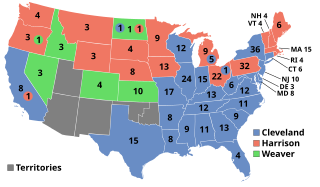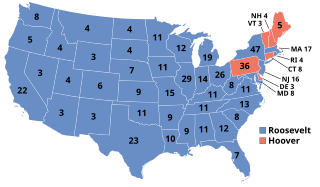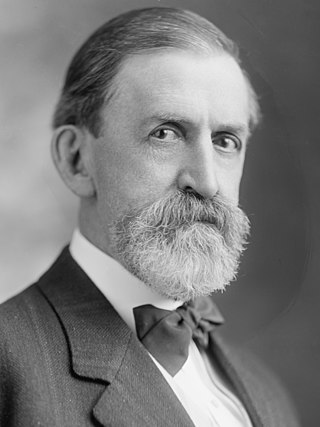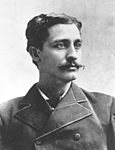
Presidential elections were held in the United States on November 7, 1876. Republican Governor Rutherford B. Hayes of Ohio very narrowly defeated Democrat Governor Samuel J. Tilden of New York. Following President Ulysses S. Grant's decision to retire after his second term, U.S. Representative James G. Blaine emerged as frontrunner for the Republican nomination; however, Blaine was unable to win a majority at the 1876 Republican National Convention, which settled on Hayes as a compromise candidate. The 1876 Democratic National Convention nominated Tilden on the second ballot.

Presidential elections were held in the United States on November 5, 1872. Incumbent President Ulysses S. Grant, the Republican nominee, defeated Democratic-endorsed Liberal Republican nominee Horace Greeley.

Presidential elections were held in the United States on November 4, 1884. Democratic Governor Grover Cleveland of New York narrowly defeated Republican James G. Blaine of Maine. It was set apart by mudslinging and personal allegations that eclipsed substantive issues, such as civil administration change. Cleveland was the first Democrat elected president of the United States since James Buchanan in 1856, the first to hold office since Andrew Johnson left the White House in 1869, and the last to hold office until Woodrow Wilson, who began his first term in 1913. For this reason, 1884 is a significant election in U.S. political history, marking an interruption in the era when Republicans largely controlled the presidency between Reconstruction and the Great Depression.

Presidential elections were held in the United States on November 6, 1888. Republican nominee Benjamin Harrison, a former U.S. senator from Indiana, defeated incumbent Democratic President Grover Cleveland of New York. It was the third of five U.S. presidential elections in which the winner did not win the national popular vote, which would not occur again until the 2000 US presidential election. Cleveland was the last incumbent Democratic president to lose reelection until Jimmy Carter in 1980.

Presidential elections were held in the United States on November 8, 1892. In the fourth rematch in American history, the Democratic nominee, former president Grover Cleveland, defeated the incumbent Republican President Benjamin Harrison. Cleveland's victory made him the first president in American history to be elected to a non-consecutive second term, a feat not repeated until Donald Trump was elected in 2024. The 1892 election saw the incumbent White House party defeated in three consecutive elections, which did not occur again until 2024.

Presidential elections were held in the United States on November 8, 1932. Against the backdrop of the Great Depression, incumbent Republican President Herbert Hoover was defeated in a landslide by Democrat Franklin D. Roosevelt, the governor of New York and the vice presidential nominee of the 1920 presidential election. The election marked the effective end of the Fourth Party System, which had been dominated by Republicans, and it was the first time since 1916 that a Democrat was elected president.

John Worth Kern was a Democratic United States Senator from Indiana. While the title was not official, he is considered to be the first Senate majority leader, while serving concurrently as chairman of the Senate Democratic Caucus. He was also the Democratic vice presidential nominee in the 1908 presidential election.
The 1884 Democratic National Convention was held July 8–11, 1884 and chose Governor Grover Cleveland of New York their presidential nominee with the former Governor Thomas A. Hendricks of Indiana as the vice presidential nominee.

The 2012 United States House of Representatives elections in Indiana were held on Tuesday, November 6, 2012, to elect the nine U.S. representatives from the state, one from each of the state's nine congressional districts. The elections coincided with the elections of other federal and state offices, including a quadrennial presidential election, an election to the U.S. Senate, and a gubernatorial election.

The 1908 United States presidential election in New York took place on November 3, 1908. All 46 contemporary states were part of the 1908 United States presidential election. Voters chose 39 electors to the Electoral College, which selected the president and vice president.
A general election was held in the U.S. state of Indiana on November 4, 2014. Three of Indiana's executive officers were up for election as well as all of Indiana's nine seats in the United States House of Representatives. The Republican nominees won all three statewide elections and all of Indiana's U.S. Representatives were re-elected.

The 1916 United States Senate election in Indiana took place on November 7, 1916. Incumbent Democratic U.S. senator and Senate Majority Leader John W. Kern ran for re-election to a second term in office, he was defeated by Republican Harry New, a former chairman of the Republican National Committee.

The 1908 United States presidential election in North Carolina took place on November 3, 1908. All contemporary 46 states were part of the 1908 United States presidential election. North Carolina voters chose 12 electors to the Electoral College, which selected the president and vice president.

The 1972 North Carolina gubernatorial election was held on November 7, 1972. Republican nominee James Holshouser defeated Democratic nominee Skipper Bowles with 51% of the vote. Holshouser thus became the first Republican elected governor of the state since 1896.

The 1944 Indiana gubernatorial election was held on November 7, 1944. Republican nominee Ralph F. Gates narrowly defeated Democratic nominee Samuel D. Jackson with 50.97% of the vote.

The 1940 Indiana gubernatorial election was held on November 5, 1940. Democratic nominee Henry F. Schricker narrowly defeated Republican nominee Glenn R. Hillis with 49.92% of the vote.

The 1896 North Carolina gubernatorial election was held on November 3, 1896. Republican nominee Daniel Lindsay Russell defeated Democratic nominee Cyrus B. Watson with 46.52% of the vote. This was the only election in North Carolina between 1872 and 1972 in which the Republican nominee won the governor's office, and the only one until 2016 in which no candidate received over 50% of the vote.

The 1876 Indiana gubernatorial election was held on October 10, 1876. Democratic nominee James D. Williams defeated Republican nominee Benjamin Harrison with 49.06% of the vote. Harrison was later elected president in 1888.

Elections were held in Illinois on Tuesday, November 3, 1936.

The 1896 Arkansas gubernatorial election was held on September 7, 1896.


















